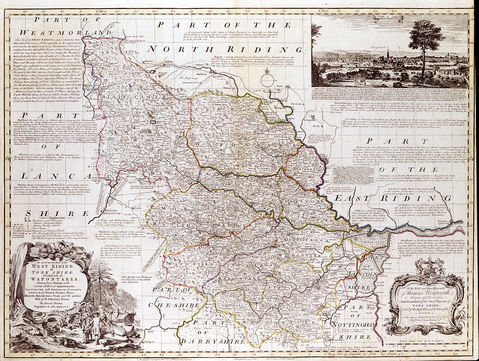Less Frequently Asked Questions
Does new or modern colour on a map devalue it?
Do you have any treasure maps or maps with "Here Be Dragons"?
Are maps cheaper on the continent, down the road, in the country, at auction, at car boot sales?
Does new or modern colour on a map devalue it?
The answer is 'it depends'. The colouring of maps may have taken place soon after printing or publication. This is regarded as 'original' or 'contemporary' colouring. However, maps may also have been coloured, or even re-coloured, at any time since. There is today a small 'cottage industry' actively involved in restoring and colouring old maps and prints.
In the broadest terms, recent colouring on a seventeenth- or eighteenth-century map does not reduce its value provided the colours used are in context with that particular map and have been properly applied. Recent colouring which is not in the correct style for that map will devalue it. There is no doubt, strictly on commercial grounds, that a map that has been recently coloured well, will sell more readily as a decorative piece than the equivalent uncoloured item. However, a badly coloured example might prove unsaleable against the black and white equivalent.
Fine original colouring on a map in excellent condition is the ideal for any collector - maps satisfying these criteria certainly command a premium price. Unfortunately, relatively few maps are found of such a standard. Personally, and without wishing to become involved in any ethical argument, my practice, as a dealer and collector, has been:
(a) to restore where necessary
(b) to leave uncoloured those maps in good condition and in notably strong black and white impressions (invariably early 'pulls' from the copperplate)
(c) when required, to have coloured correctly those maps which will visually benefit; where the quality of engraving will not be obscured; and, in general, to colour only those maps which one might reasonably expect to find 'originally' coloured (i.e., to colour an early Ptolemaic copperplate would not be appropriate whereas to colour a map by Blaeu or Ortelius correctly would be acceptable, given that these maps are often found in early colour).
Until the collector has sufficient experience to identify the age of colour himself he will be dependent on the dealer's expertise. Identifying the age of colour is not always easy but more often than not the experienced dealer can be confident in his opinion.
As I have said there is undoubtedly a premium on fine original colour but, beyond that, colour applied for instance, by a Victorian colourist to a seventeenth
or eighteenth-century map is certainly not modern. Equally, colour applied recently will soon no longer be modern. The final judge as to what is acceptable must be the collector and purchaser. Tradition has shown a place in the market for fine black and white maps, though popular demand through the centuries has been for finely and correctly hand-coloured, visually decorative pieces.
Do you have any treasure maps or maps with "Here Be Dragons"?
The notion that “Here Be Dragons” was a frequent phrase used by early English mapmakers seems to be fixed in the international consciousness. However, there is no current evidence to suggest this phrase ever appeared on an English map from the early days of exploration. In fact, why should it when Latin was the language of learning? The most thorough and recent research that we know of on this subject may be found courtesy of Dr. Erin Blake at www.maphist.nl/extra/herebedragons.html. She states that only the Lennox Globe held by the New York Public Library (c.1503-1507) evidences “HC SVNT DRACONES”.
Are maps cheaper on the continent, down the road, in the country, at auction, at car boot sales?
Everybody likes to know that they are paying a fair price for whatever they might buy. This holds true for antique maps, especially as there is no “fixed” price for any particular map.
An experienced dealer will know his market and what a map can be sold for based on previous price records, current trends and, very simply, supply and demand. An inexperienced seller is as likely to over price as he is to under price, as he lacks that comparative, historical knowledge and is frightened of selling too cheaply. As a buyer you might be lucky, although we hear far more tales of misfortune. The risks of buying from unaccredited sources leaves the buyer with questions perhaps of legitimate ownership, quality of condition, genuineness and correct description.
With regards to buying at auction, any dealer with some experience will recount instances of maps selling for more in auction than in retail shops. Auction fever, competitiveness and the thought of outsmarting others often encourage buyers to exceed their limits and, with buyers premium of perhaps 20% added – whoops!
Buying from accredited dealers, perhaps members of their national, or international, trade associations, carries a guarantee of description, refundability and integrity not easily gained by the dealer and not easily found among non-specialists.
What is a 'hundred'?
The hundred was a geographic subdivision of the courts of the shire which characterised the administration prior to the reign of Henry II (1154-89). Enforced at the creation of English common law, these administrative areas largely remained under royal control, heralding the Anglo-Saxon tradition of law-making which focused on the king as protector of the realm. A division used in England, Denmark, southern Australia, and some parts of the USA, Germany, Sweden and Norway, the hundred is alternatively referred to as both a Wapentake and a Herred (Danish and Norwegian, respectively), as well as a Härad (Swedish).
It has been suggested that the name may have, in some areas, once referred to a hundred men under arms. In England, however, it signified a quantity of land sufficient to sustain one-hundred households. The system of hundreds was not as stable as the system of counties established at the time: lists of the hundreds in each shire i.e. those in the Domesday Book, frequently differ. Hundred boundaries were also independent of both parish and county boundaries: a hundred could be split between counties, or a parish could be split between hundreds. To make things even more complicated, the counties of Yorkshire, Derbyshire, Leicestershire, Northamptonshire, Nottinghamshire, Rutland and Lincolnshire were divided into
wapentakes, not hundreds.

Though hundreds were never formally abolished, by the nineteenth century several new and more appropriate subdivisions of counties had sprung up, leaving the hundred redundant.
What about provenance?
The word applies to the historical ownership of an item and, in the case of many important antiques and artworks, is a matter of great significance in establishing the legitimate marketing of an item. Much has been written in recent times about the provenance of antiquities with public arguments over the Elgin Marbles, the Soveso Silver and innumerable pieces from archaeological sites in the Middle East and all parts of Asia.
With regard to maps and atlases, provenance, where it can be established, is undoubtedly of significance but absence of provenance does not, in itself, imply any doubts as to the legitimacy of an item on the market. The nature of this business is such that, as values of maps and atlases have only recently started to compare with art and antiques, records of disposals from libraries, public and private collections have not always been maintained to the level now hoped for. Only a tiny proportion of goods coming into this market have fully traceable records of ownership from their time of publication to the present day.
The map and colour-plate print business has expanded dramatically over the last sixty to seventy years and it would prove impossible to identify the actual original volume and its various owners, from which most maps on the market have come. However, caution is required for purchases at the higher end of the price range. Atlases have traditionally been books that have suffered due to practical usage – think how one might treat a road atlas or an out-of-date world atlas now – and maps have often been taken from books for quite legitimate reasons. Sadly though, over the last few decades, thieves have seen the rising value of certain maps and the ease with which they can be filched from some libraries and a number of court cases have arisen.


